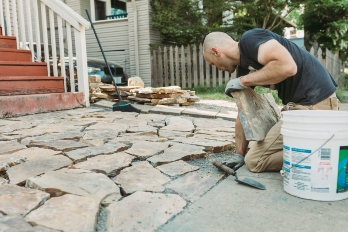What are closing documents? They’re the big pile of paperwork between you and your new home. And we do mean big. You’ll feel a lot less stressed on closing day if you know what’s coming. You might even avoid a costly mistake. So we’re here to help you get familiar with the key documents you’ll be signing or reviewing.
The nine documents we’ve described below are the main ones in most places, but real estate and mortgage paperwork varies depending on where you live and the details of the sale. Homebuyers can expect to sign any number of other statements, disclosures, acknowledgments … It can take an hour or more to get through it all.
Given the amount of paperwork, it’s no surprise that errors are one of the more common problems at closing. Sometimes you can get copies of certain documents in advance, and even sign them electronically, which makes it easier to review them thoroughly. Ask your lender or closing agent.
Just take your time, both before and during your closing. The number-one mistake might be to let anyone rush you. You want to walk out of there excited and relieved, not wondering whether you just signed away your firstborn.
1. Closing disclosure: All the details of your loan
Required by federal law for all home purchases, the Closing Disclosure is designed to make sure you understand exactly what you’re getting into when you sign your mortgage loan.
In this key document, your lender outlines the final terms of your loan: the annual percentage rate, the interest rate, your projected monthly payment, and other important details. They also detail your closing costs and who pays and who receives money at closing. The Closing Disclosure shouldn’t depart much from the Loan Estimate you got after you applied for your loan — legally, your lender is allowed to change certain numbers, but not others.
While it’s your responsibility to review and understand the Closing Disclosure, your lender has a big legal responsibility to get the numbers right. If something changed that shouldn’t have, you have the right to cancel your loan for up to three years.
To ensure that you have time to review the Closing Disclosure carefully and ask any questions, your lender is required to get it to you at least three business days before the closing. It’s a notice, not a contract, but you might be asked to sign a form acknowledging that you received it or to sign the document itself when you’re ready.
The Closing Disclosure is fairly straightforward, but long — five pages.
2. Your loan application: A simple double-check
Remember the form you filled out when you first applied for your loan? Here it comes again. Your lender makes a fresh copy for the closing, and you’ll double-check it for accuracy and sign it.
If anything relevant has changed since you first applied, you must tell your lender before signing. Did you change jobs? Take on a new credit card or any new debt?
3. Mortgage note: Your commitment to the loan
Most people refer to the loan as “the mortgage,” but technically it’s the mortgage note that legally binds you to repaying the loan. It’s also called the promissory note. And it’s another long document, 7 to 12 pages.
Besides listing all the borrowers, it covers the following:
- The amount you owe, the principal
- The interest rate of the loan
- The dates when the payments are to be made
- The total you’ll pay over the life of the loan
- The length of time, or term, for repayment
- Whether and how the payment amounts can change
- Where to send your payments
- What happens if you don’t make your payments
4. Mortgage: Putting up your house as collateral
The mortgage, sometimes called a deed of trust or security instrument, provides security for the loan and is legally binding.
What that means is that when you sign, you’re putting up your house as collateral. If you default on the mortgage note, the lender can foreclose on your home, sell it, and use the money to pay the loan balance and foreclosure costs.
The mortgage is recorded in the county recorder’s office as a public record that the bank owns an interest in your home.
5. Title documents: Clear rights to your home
In real estate, “title” means you own a right to a property, not that you own it, per se. Title documents record your right to your home. Technically, you won’t truly own it until you pay it off, at which point you’ll possess both the title and the deed (see number 6).
The main title document is the title insurance “commitment,” which should list the seller as the “party in title.” It should also list any liens — legal claims due to unpaid debt — or other complications, although hopefully there aren’t any. (If there are, you should probably have a real estate attorney in your corner.)
There shouldn’t be any surprises here. By the time you’re at the closing table, a title company has already researched the title and issued title insurance policies to both your lender and you (read about the overall closing process for details). You just need to confirm that the title is as expected. And if it’s not? The closing will grind to a halt until the title is clear.
6. Deed: Proof of your ownership
The deed transfers the property title (see number 5) from the seller to you and usually describes the property in detail.
The buyer doesn’t sign this document; the seller does. At the closing, it will already be signed and notarized, naming you and any other buyers as the new owners. Make sure it’s accurate. Disputes about ownership are often settled based on whose name is on the deed.
The signed deed goes to the county recorder of deeds to be recorded. This adds you to the property’s history of ownership, called the “chain of title,” and creates a public record that you are the current rightful owner.
7. Affidavits: Sworn statements
Affidavits are sworn, notarized statements that verify information. You might need to sign several; you can ask your closing agent about this ahead of time.
At a minimum, you’ll probably have to confirm your legal name and state that to the best of your knowledge, all the information you’re providing is true. You might also be asked to certify that you will occupy the home as your primary residence.
Not that you would provide false information, but FYI, that could cancel your loan and lead to criminal penalties.
8. Initial escrow disclosure: Your other new expenses
This federally required document is an accounting of your loan-related financial obligations beyond the loan itself, as reflected by your escrow account.
Your closing costs include a deposit for your escrow account, which is established at closing. The total deposit shouldn’t be a surprise — it’s on the Closing Disclosure. But this disclosure goes into more detail. It lists all the expenses your lender expects to payout from your account, and when, during the first year of your loan. Escrowed expenses can include property taxes, homeowners insurance, PMI, homeowners association dues, and other charges.
While the initial escrow disclosure is usually presented on closing day, lenders are allowed to get it to you up to 45 days after they establish your account. Then, they’re required to send you an escrow account statement annually.
9. Transfer tax declaration: More fees, maybe
Many states, counties, and municipal governments impose a tax on property transfers. If this applies to you, both you and the seller must sign declarations that disclose the purchase price and calculate the tax.
Ready to take the next step in your homebuying journey with all the confidence of a smart and savvy homebuyer? Our comprehensive online homebuyer course is simple and easy to access on your computer, tablet, and mobile device. It’s all the information you need, all in one place. Go ahead and get started today.




